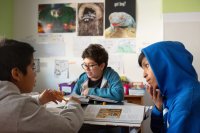5 Ways to Promote Healthy Discourse During Project-Based Learning
Encouraging middle and high school students to talk through differences of opinion can make for stronger projects and greater learning gains.
Your content has been saved!
Go to My Saved Content.Organizational theorists have long argued that the default way in which people engage in dialogue is simply not conducive to actual learning. The preset mode for most people is to withhold assumptions, keep the sharing of rationale and intent largely private, and provide and advocate for a particular position by either verbalizing their ideas or remaining quiet. This can manifest in many ways, but the most common is advocacy (sharing my side with conviction) or avoidance (staying away from the discussion altogether and keeping my ideas private).
In other words, we seem to do well with telling others what to do or what we think, but we tend to suffer mightily from listening to others and working through their ideas. We typically pull stronger for our ideas or give up and capitulate to theirs. We tend to see groups pivot from “I do” to “you do” without “we do.''
A number of studies on problem- and project-based learning show that group collaboration is fraught with challenges. For instance, in one study that looked at collaboration among adults in a PBL environment, teams did not engage in meaningful discussions. They lacked an effective approach to critical thinking, including sharing, weighing, and evaluating diverse opinions, or coming to an agreement on a shared solution.
A similar story is occurring across classrooms in the United States. Most students simply focus on completing tasks and approaching a divide-and-conquer scheme to get through the myriad of tasks assigned to groups while avoiding conflict at all costs. Unfortunately, this manifests as students being concerned with the amount of work each person is doing versus the overall quality of the group’s discourse.
But research illustrates that when done correctly, collaboration is critical for student learning. In an analysis of studies about learning strategies, the case was made that feedback from peers and classroom discussion not only double the rate of learning but are bedrock strategies for students to develop deeper learning (i.e., analysis, synthesis, and evaluation). In other words, the only way to fully achieve mastery is through high-quality social interactions.
How Do We Go From Advocacy or Avoidance to Inquiry and Engagement?
I have found that one of the most effective and efficient ways to design discussions for learning is to follow a five-step plan.
1. Create and monitor conversational agreements. We often have norms for behavioral expectations for our classroom. The recommendation here is to add engagement expectations when working with others to create rigorous discussions. The introduction of these agreements is easier than living them day by day. We have all seen the norms on the board, but we don’t live them or follow them. One way to think of it is to treat agreements like putting on a mask. It’s not the most comfortable, it feels awkward, and we don’t see the immediate impact, but it’s critical to our well-being and that of others. Taking time to model, remind, and reinforce engagement agreements is critical for conducting high-quality student interactions.
- State views and ask genuine questions. (Speak like you are right, and listen like you are wrong.)
- Explain reasoning and intent. (This is why I think we should do… And my purpose is…)
- Focus on interests, not positions. (At the end of the day, I want us to…)
- Test assumptions and inferences. (I’m assuming…)
- Jointly design next steps. (Our next four steps include…)
2. Create process roles. We have an opportunity to shift away from product-management roles (leader, timekeeper, recorder, tech person) to interaction-based roles. Students can use questions related to their role to keep the group on track.
- Process role: Are we following our agreements? Are we sticking to our agenda? Do we know our next steps? Do we know how we will check for our progress?
- Perspective role: Are we hearing from everyone? And from every viewpoint?
- Precision role: Do we have the facts right? Are these decisions based on our collective understanding?
3. Implement protocols with fidelity. When designing and implementing protocols, divide up the discussions into protocols for tasks (reading, writing, and talking activities), problem solving, and feedback. There are a number of great protocols available online to choose from in the areas of content, problem-solving, and feedback.
- Content: Final Word, Discussion Mapping, Socratic Seminar, Four Corners
- Problem-solving: K-W-L Charts, World Cafe, Nominal Group Technique, Open Space
- Feedback: Tuning Protocol, TAG Protocol, Post-It Note Technique, Consultancy Dilemma
4. Sequence protocols throughout the PBL process. Project-based learning is simply a methodology that begins with a problem that requires transfer, moves to building and reinforcing knowledge and skills, and finally comes back to solving the original problem. Within these phases of a project, the placements of certain protocols are critical. For example, K-W-L Charts is a protocol that helps students understand a challenging problem at the beginning of the unit. Chalk talk, Four As, and Socratic seminars are all protocols that support students in building and deepening reinforcing knowledge. As they progress toward solving the original problem, students begin using the problem-based and feedback strategies mentioned earlier.
5. Model these approaches with your own adult teams. Finally, the best way to gain proficiency in using these protocols is through practice. One of the best ways to practice is using these protocols with colleagues. In addition, practicing these protocols with students using information they’re familiar with is an easy way for students to develop proficiency of the protocol and not risk overwhelming their working memory. Over time and with practice, students and teachers will be able to shift from our default of advocacy or avoidance to one of authentic engagement and inquiry.
